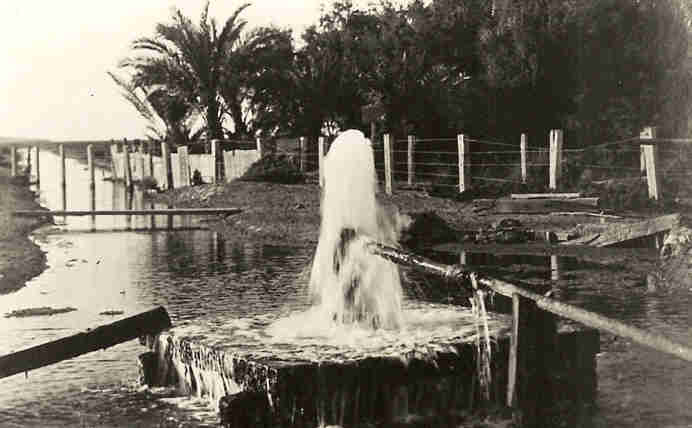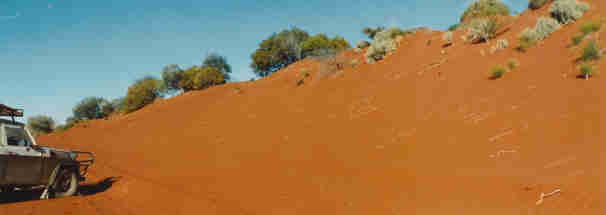To resume the journey. For a long distance the line traverses the Stuart's Creek Run, which was originally held by J. and J. Chambers, and was the starting point of John McDouall Stuart's expedition across the continent. A great amount of money has been spent in artesian boring on the southern portion of the property. My impressions of this station had been formed after a view of photographs of the lovely waterholes hanging in the Adelaide offices of the Willowie Pastoral Company, but on passing through it, I came to the conclusion that the photographer had been snapping mirages. But what one sees from the train is not by any means a fair index of the general condition of the run, and from what Mr. Paxton said, the afore mentioned shivering goat was not in for such a bad time after all.
To illustrate his words he produced from his tucker bag, and allowed us to sample, one of the choicest ox tongues ever seen inside or outside of a butcher's shop. Recently Stuart's Creek had been favoured with heavy rains, but owing to the freezing weather, the season has been one of the coldest on record, the feed had not made the usual rapid growth. However, there is still plenty of moisture in the ground, and the warmer weather approaching; a great improvement in vegetation will soon be noticed. All the numerous clay pans were covered with water.
A Plague of Rats. Recently Stuart's Creek was visited by a plague of rats endowed with a pug nose. They appeared with startling suddenness and vanished in the magical way characteristic of most plagues. This particular breed had never been known here before but they turned up in hundreds of thousands and vigorously attacked the saccharine matter in the grasses and roots. Mr. Paxton forwarded a few specimens to Professor Stirling at the Adelaide Museum, who was very pleased to receive them. The Professor sought full information concerning them, saying that very little was known of the habits of this and other allied rats in Australia. The creatures were comparatively tame, and unhesitatingly walked into traps set for them.
By the time the discussion on Angora goats, pug-nosed rats, and clay pan squatters had ended the train had entered well upon Stuart's Creek Run, which embraces Mount Hamilton Station, occupied in the early sixties by the late Mr. Peter Ferguson, and afterwards by Mr. Thomas Ilbry.
Near Mount Hamilton is the celebrated spring known as the Blanche Cup, raised in a soda mound about 30 ft. above the level of the surrounding country. The land in the immediate vicinity is barren, because the quality of the water is fatal to vegetation, and the uninformed thirsty man would shun the mound as he would a mirage.

Strangways Springs bore. |
Set in the top of this uninviting hillock is the Blanche Cup, containing an inexhaustible and unfathomable supply of bright, clear looking water, a little warm and slightly brackish, but agreeable to the taste and eagerly accepted by stock. The basin is about 30 ft. across, and over the edge of this natural tank the water gently spills, and no perceptible change in the supply takes place. Nearby is a smaller and warmer spring that remains peaceful and clear for a few minutes at a time, and then bubbles and boils up, disturbing the sand and causing a momentary overflow onto the plain.
The scenery in the immediate vicinity includes several of the tent-like hills, of which there are some excellent examples west of Port Augusta. Approaching Stuart's Creek Railway Station one gets the first and only glimpse of the southern portion of Lake Eyre, the largest salt lake in Australia, the bed of which is 38ft. below sea level. Most watercourses south of Leigh's Creek run into Lake Torrens, and those north of Leigh's Creek patronise Lake Eyre. That huge basin is the home of many large streams in flood time, and it now contains a large volume of water nearly as salt as the Dead Sea.
Coward Springs and Further On. Plenty of the stony country that helps to generate Adelaide's hot winds had been traversed by this time, but a welcome break is provided at Coward Springs, where one of our most successful artesian bores (308 ft. deep) is located. It is within a stone's throw of the railway, and newcomers scuttle out of the train for a closer touch with the novelty. The flow has been artificially reduced to about one-fourth of the original supply to prevent a collapse of the work, but the water still spurts up steadily and prettily from the standpipe as warm as ever.
It runs for about eight miles into the plain, supporting tamarisks and date palms at the head and a rank growth of reeds and rushes along the course of the channel. The principal product of the Coward bore, however, consists of dead cattle, for a lot of country has been rendered boggy, and weak stock are lured to destruction. Stuart's Creek Run embraces this artesian water, which is unsuited to railway or domestic purposes.
Beresford is the next stopping place, and here are the Beresford Springs, so called after a former Clerk of Parliament, lying between two hills of the same name. The big railway dam was full to overflowing. Then we come to Strangways Springs, which issue from mounds in sight of a strange rock formation.
Another bore (365 ft. deep) is here, the flow from which has produced the same old lagoon and bog, and the same old reeds and rushes. We are now upon Messrs. Hogarth & Warren's Anna Creek Station, which is tapped by the railway at William Creek further on. It carries about 37,000 sheep and 2,500 cattle. Shearing is over, and the siding at William Creek held a string of trucks laden with well-pressed wool, while bullock teams were on the road bringing in more of the clip. The feed within sight of the line was pretty sick, but it was stated that at the northern end of the run the country was in exceptionally good condition.
The only refreshment room on this day's stage to Oodnadatta is at William Creek. A fellow-traveller stated that two years ago last Easter he entered it with a party of 23 bound for Arltunga. The proprietress having expected only the ordinary traffic was in a dilemma, for she had to satisfy 23 hungry men off one shoulder of mutton. Then one of the party volunteered to localize the parable of the loaves and fishes, and did it 'so successfully that the proprietress resolutely declined to accept payment for the carver's meal. "No sir; you have been a good Samaritan to me."
William Creek, besides supporting a refreshment room, boasts a sulphur spring, which forms a lake on top of a sand hill, raised about 25 ft. above the level of the surrounding country. The water is beautifully fresh and clear. Sand hills and stones which give the land the appearance of fallowed ground meet the eye at every turn after leaving William Creek, but the country improved approaching Edward's Creek, where the locomotive took in water, said to be the best on the line, from a splendid well.
Then the track runs through Nilpinna Station, occupied by Mr. R. G. Allen, the well-known horse breeder, who alighted at Warrina on a visit to his run. He intends to bring down a big mob of horses during show week. He depends largely upon the Indian market, and judging by the splendid condition of the bush and young grass on Nilpinna he should be able to muster a fine lot. Mr. Allen's headquarters are on the west side of the line, and to the east is the well-known Peake Station, where the late Mr. E. 0. Kempe, in partnership with Mr. Kidman, carried on operations.

Oodnadatta Track 1981. |
The community to meet the train at Warrina consisted mostly of natives of both sexes leavened by a white lady, who looks after the telephone and railway station. The Peake Run was originally taken up by the late Mr. Philip Levi, under the management of Mr. Stephen Jarvis. It was stocked with horses, cattle, and sheep, a great many well-bred young ewes being sent from the Gum Creek Estate, while well-selected Shorthorns from the late Mr. Angas' stud formed the nucleus of the cattle herd. The Peake was afterwards sold to Messrs. J. & C.M. Bagot. It is now stocked with horses, cattle, and Angora goats.
What an enterprising man Mr. Levi was! At one time he held as much country as any other four pastoralists in South Australia. He owned or was partly interested in the following stations: Gum Creek, Mount Margaret, Coffin's Bav. Oulnina. Wadnaminga. part of Parnaroo. Callanna, Marraehowie, Minburra, North-West Bend, Wirrialpa, Moolooloo. Witchelina and Booleroo.
A Costly Bridge. A run of 20 miles brings us to Algebuckina, a big and picturesque waterhole in the Neales Creek one of the principal watercourses in the nor' west, emptying itself into Lake Eyre. Nearly every carriage window frames a head as the great bridge over the Neales is crossed. It represents an outlay of the best part of 100.000 and as the second largest bridge in South Australia, is a monument of ill-considered expenditure. The length of it is about 2,000 ft. and the substantial iron girders are in spans of 101 ft. The columns are 12 ft. deep in the ground and are filled up with concrete. There was a strong feeling against the erection of such a costly bridge, but the engineers said it was necessary and had their way and posterity continues to pay the piper.
A large proportion of the outlay might have been saved by running the line across the creek, which is flooded only once in three or four years, not a serious matter on a railway supporting only one train a fortnight. Still, it is a grand piece of work, and one of the show spots of the whole journey. In the neighbourhood of Algebuckina gold has been got for many years in small quantities, and this is also the locality of the Coppertop Mine, unprofitably worked by a Melbourne company.
The Terminus. Only one more station separates Oodnadatta and that is Mount Dutton where Messrs Giles & Martin, who are engaged in pastoral pursuits, met the train. A final run of 26 miles and we glided into Oodnadatta (688 miles from Adelaide) at sundown. The atmosphere was perceptibly warmer and more agreeable. The first thing that struck one was the familiar railway notice, Look out for the train. What irony! One train a fortnight, and the whole populace, who dwell on its coming, are warned to "look out." The Transcontinental Hotel, owned by a well-known identity (Mr. Joe Harding), and managed by Mr. Henderson, appears inviting after the long day's travel, and we may leave an inspection of the railway terminus until the next day.
********************
If you would like to find out more,


please go
to home page for more information.
Thank you for visiting South Australian History,
We hope you enjoy your stay and find the information useful.
This site has been designed and is maintained by FRR.


|





